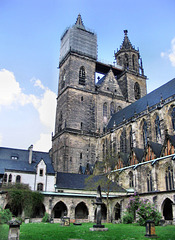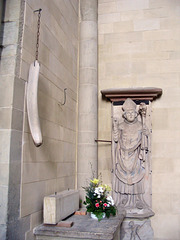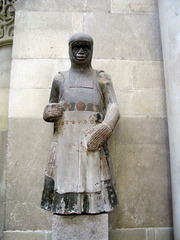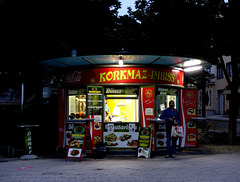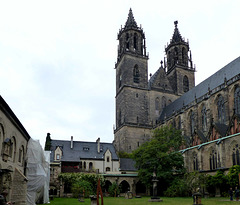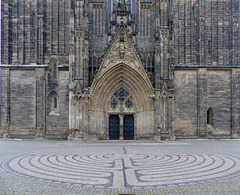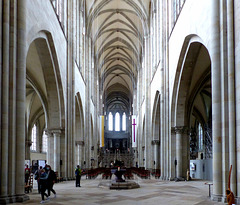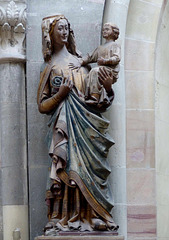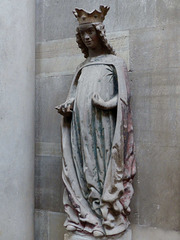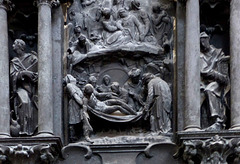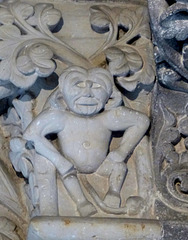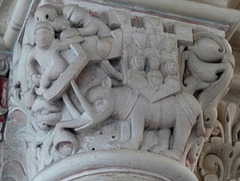
Saxony-Anhalt / Sachsen-Anhalt
Magdeburg - Cathedral
| |
|
The construction of the "Cathedral of Saints Catherine and Maurice" started 1209. Two years ago, the church that had been on this place since 932, burnt down with most of the town on Good Friday . This
is one of the oldest churches in Germany, clearly influenced by the then new gothic style, developed in France. Otto I the Great and his wife Edith of England have their graves here (see below). The steeples (finished 1520) seen here from the cloister are about 100m in height. The cloister itself dates back to 1160, when it was used by the benedictine monks of the monastry "St. Maurice".
During the Thirty Years' War (1618–1648) Magdeburg was raided and probably 20.000 inhabitants lost their lives. A small group of 4000 people survived the "Sack of Magdeburg" by seeking refuge in the cathedral. Begging on his knees before the conqueror the head priest saved them.
Here is the grave of the "royal couple":
www.flickr.com/photos/martin-m-miles/4328456651/
Magdeburg - Cathedral
| |
|
A baroque statue of a bishop to the right, a whalebone to the left. A curiosity in the Magdeburg Cathedral. I have no idea, what a whalebone "means" or what it stands for. It may be connected to Matthew 12:38-41
"For as Jonas was three days and three nights in the whale's belly; so shall
the Son of man be three days and three nights in the heart of the earth."
There are a couple of churches, that display whalebones.
Cologne (Germany):
www.flickr.com/photos/roland-rossner/2786317321/
Herford (Germany):
www.flickr.com/photos/martin-m-miles/4765219389/
Gandersheim (Germany):
www.flickr.com/photos/martin-m-miles/5706420469/
Rieupeyroux (France):
www.flickr.com/photos/lionfranc37/5340136898/in/contacts/
Krakow (Poland)
www.flickr.com/photos/tanya780/2740547999/
Magdeburg Cathedral
| |
|
This couple, carved in the 14th. century, is assumed to represent Otto I the Great and his (first) wife Editha of England (910-946). Her coffin was opened in 2008 by archaeologists. An inscription recorded that it was the body of Eadgyth, reburied in 1510. The remains were brought to England, for tests. Professor Mark Horton of Bristol University said that "this may prove to be the oldest complete remains of an English royal." - says Wikipedia.
-
Professor Horton was right (see below).
Meanwhile (2010) the remains of Editha are buried again.
Here is a very interesting 5-min-video about the archeological research:
www.youtube.com/watch?v=YfmkWvgDr_k
Magdeburg Cathedral
| |
|
In the Magdeburg Cathedral is the oldest known image depicting Saint Maurice as a Moor ( = Mauritius). The statue is carved around 1250 and shows him as an armoured knight. It could well be, that this statue is the oldest picture of an ethnic African in Mid-Europe.
St.. Maurice was a leader of the Theban Legion. Tradition tells, that the complete legion converted to Christianity within the 3rd century - and later got the title "Martyrs of Agaunum".
As the soldiers refused to prosecute and punish fellow Christians, every tenth soldier got executed. This happened at least twice. Some places in Germany (Bonn, Cologne, Xanten,
Trier) claim to be the place where these legionnaires were martyred. In the end, all soldiers of the Theban Legion were executed in Agaunum, nowadays named "Saint-Maurice"
in Switzerland.
Magdeburg - Cathedral
| |
|
The cathedral, officially called "Cathedral of Saints Catherine and Maurice", hosts the oldest known image depicting Saint Maurice as a Moor, carved around 1250. This statue of Saint Maurice is clearly younger, but as well, shows an armoured knight, who is obviously an ethnic African.
Here is the older statue of Saint Maurice:
www.flickr.com/photos/martin-m-miles/4329165066/
Gernrode
| |
|
..."Siftkirche St. Cyriakus" in Gernrode on the eastern slopes of the Harz mountain range. Constructed around 1000. A model of the Ottonian style in Romanesque architecture...
Magdeburg - Korkmaz Imbiss
| |
|
|
Founded by Charlemagne in 805 as Magadoburg, the town was fortified in 919 by King Henry the Fowler against the Magyars and Slavs. In 929 King Otto I granted the city to his English-born wife Edith as dower. At her death, Queen Edith was buried in the crypt of the Benedictine abbey of Saint Maurice, later rebuilt as the cathedral. In 937, Magdeburg was the seat of a royal assembly. Otto I was buried as well in the cathedral.
In 1035 Magdeburg received a patent giving the city the right to hold trade exhibitions and conventions. This was the basis of town law to become known as the Magdeburg rights. These laws were adopted and modified throughout Central and Eastern Europe.
In the 13th century, Magdeburg became a member of the Hanseatic League. With more than 20,000 inhabitants Magdeburg was one of the largest cities in the Holy Roman Empire.
During the Thirty Years' War (1618–1648) Magdeburg was raided and probably 20.000 inhabitants lost their lives. A small group of 4000 people survived the "Sack of Magdeburg" by seeking refuge in the cathedral. Begging on hid knees before the conqueror the head priest saved them.
-
Deep in the night, the snack bar lights up and offers beer and kebab.
Magdeburg - Dom
| |
|
|
|
Founded by Charlemagne in 805 as Magadoburg, the town was fortified in 919 by King Henry the Fowler against the Magyars and Slavs. In 929 King Otto I granted the city to his English-born wife Edith as dower. At her death, Queen Edith was buried in the crypt of the Benedictine abbey of Saint Maurice, later rebuilt as the cathedral. In 937, Magdeburg was the seat of a royal assembly. Otto I was buried as well in the cathedral.
In 1035 Magdeburg received a patent giving the city the right to hold trade exhibitions and conventions. This was the basis of town law to become known as the Magdeburg rights. These laws were adopted and modified throughout Central and Eastern Europe.
In the 13th century, Magdeburg became a member of the Hanseatic League. With more than 20,000 inhabitants Magdeburg was one of the largest cities in the Holy Roman Empire.
During the Thirty Years' War (1618–1648) Magdeburg was raided and probably 20.000 inhabitants lost their lives. A small group of 4000 people survived the "Sack of Magdeburg" by seeking refuge in the cathedral. Begging on hid knees before the conqueror the head priest saved them.
-
The construction of the "Cathedral of Saints Catherine and Maurice" started in 1209. Two years ago, the church that had been in this place since 932, burnt down with most of the town. This church is influenced by the then-new gothic style, developed in France. Otto I the Great and his wife Edith of England have their graves here.
The construction stopped after 1274. In 1325, Archbishop Burchard III. was killed by the people of Magdeburg because of extreme taxes. Folklore says that especially the beer tax increase caused much anger. Afterward, Magdeburg was under a ban, and only after the donation of five atonement altars did the construction of the cathedral continue. In 1360 the construction stopped again for many decades. Only in 1477 did the construction started again. The towers were constructed by master builder Bastian Binder, the only master builder of the cathedral known by name. The construction of the cathedral was completed in 1520.
Today it is the principal church of the Evangelical Church in Central Germany.
Magdeburg - Dom
| |
|
|
Founded by Charlemagne in 805 as Magadoburg, the town was fortified in 919 by King Henry the Fowler against the Magyars and Slavs. In 929 King Otto I granted the city to his English-born wife Edith as dower. At her death, Queen Edith was buried in the crypt of the Benedictine abbey of Saint Maurice, later rebuilt as the cathedral. In 937, Magdeburg was the seat of a royal assembly. Otto I was buried as well in the cathedral.
In 1035 Magdeburg received a patent giving the city the right to hold trade exhibitions and conventions. This was the basis of town law to become known as the Magdeburg rights. These laws were adopted and modified throughout Central and Eastern Europe.
In the 13th century, Magdeburg became a member of the Hanseatic League. With more than 20,000 inhabitants Magdeburg was one of the largest cities in the Holy Roman Empire.
During the Thirty Years' War (1618–1648) Magdeburg was raided and probably 20.000 inhabitants lost their lives. A small group of 4000 people survived the "Sack of Magdeburg" by seeking refuge in the cathedral. Begging on hid knees before the conqueror the head priest saved them.
-
The construction of the "Cathedral of Saints Catherine and Maurice" started in 1209. Two years ago, the church that had been in this place since 932, burnt down with most of the town. This church is influenced by the then-new gothic style, developed in France. Otto I the Great and his wife Edith of England have their graves here.
The construction stopped after 1274. In 1325, Archbishop Burchard III. was killed by the people of Magdeburg because of extreme taxes. Folklore says that especially the beer tax increase caused much anger. Afterward, Magdeburg was under a ban, and only after the donation of five atonement altars did the construction of the cathedral continue. In 1360 the construction stopped again for many decades. Only in 1477 did the construction started again. The towers were constructed by master builder Bastian Binder, the only master builder of the cathedral known by name. The construction of the cathedral was completed in 1520.
Today it is the principal church of the Evangelical Church in Central Germany.
Magdeburg - Dom
| |
|
|
Founded by Charlemagne in 805 as Magadoburg, the town was fortified in 919 by King Henry the Fowler against the Magyars and Slavs. In 929 King Otto I granted the city to his English-born wife Edith as dower. At her death, Queen Edith was buried in the crypt of the Benedictine abbey of Saint Maurice, later rebuilt as the cathedral. In 937, Magdeburg was the seat of a royal assembly. Otto I was buried as well in the cathedral.
In 1035 Magdeburg received a patent giving the city the right to hold trade exhibitions and conventions. This was the basis of town law to become known as the Magdeburg rights. These laws were adopted and modified throughout Central and Eastern Europe.
In the 13th century, Magdeburg became a member of the Hanseatic League. With more than 20,000 inhabitants Magdeburg was one of the largest cities in the Holy Roman Empire.
During the Thirty Years' War (1618–1648) Magdeburg was raided and probably 20.000 inhabitants lost their lives. A small group of 4000 people survived the "Sack of Magdeburg" by seeking refuge in the cathedral. Begging on hid knees before the conqueror the head priest saved them.
-
The construction of the "Cathedral of Saints Catherine and Maurice" started in 1209. Two years ago, the church that had been in this place since 932, burnt down with most of the town. This church is influenced by the then-new gothic style, developed in France. Otto I the Great and his wife Edith of England have their graves here.
The construction stopped after 1274. In 1325, Archbishop Burchard III. was killed by the people of Magdeburg because of extreme taxes. Folklore says that especially the beer tax increase caused much anger. Afterward, Magdeburg was under a ban, and only after the donation of five atonement altars did the construction of the cathedral continue. In 1360 the construction stopped again for many decades. Only in 1477 did the construction start again. The towers were constructed by master builder Bastian Binder, the only master builder of the cathedral known by name. The construction of the cathedral was completed in 1520.
Today it is the principal church of the Evangelical Church in Central Germany. The cathedral is 117 meters long and 40 meters wide.
Magdeburg - Dom
| |
|
|
Founded by Charlemagne in 805 as Magadoburg, the town was fortified in 919 by King Henry the Fowler against the Magyars and Slavs. In 929 King Otto I granted the city to his English-born wife Edith as dower. At her death, Queen Edith was buried in the crypt of the Benedictine abbey of Saint Maurice, later rebuilt as the cathedral. In 937, Magdeburg was the seat of a royal assembly. Otto I was buried as well in the cathedral.
In 1035 Magdeburg received a patent giving the city the right to hold trade exhibitions and conventions. This was the basis of town law to become known as the Magdeburg rights. These laws were adopted and modified throughout Central and Eastern Europe.
In the 13th century, Magdeburg became a member of the Hanseatic League. With more than 20,000 inhabitants Magdeburg was one of the largest cities in the Holy Roman Empire.
During the Thirty Years' War (1618–1648) Magdeburg was raided and probably 20.000 inhabitants lost their lives. A small group of 4000 people survived the "Sack of Magdeburg" by seeking refuge in the cathedral. Begging on hid knees before the conqueror the head priest saved them.
-
The construction of the "Cathedral of Saints Catherine and Maurice" started in 1209. Two years ago, the church that had been in this place since 932, burnt down with most of the town. This church is influenced by the then-new gothic style, developed in France. Otto I the Great and his wife Edith of England have their graves here.
The construction stopped after 1274. In 1325, Archbishop Burchard III. was killed by the people of Magdeburg because of extreme taxes. Folklore says that especially the beer tax increase caused much anger. Afterward, Magdeburg was under a ban, and only after the donation of five atonement altars did the construction of the cathedral continue. In 1360 the construction stopped again for many decades. Only in 1477 did the construction start again. The towers were constructed by master builder Bastian Binder, the only master builder of the cathedral known by name. The construction of the cathedral was completed in 1520.
Although the cathedral was looted several times during its history, many valuable furnishings and art treasures have been preserved, which were moved out and secured during the bombardments of WWII.
Side altar with sandstone reredos of Anna Selbdritt (~1520).
Magdeburg - Dom
| |
|
|
Founded by Charlemagne in 805 as Magadoburg, the town was fortified in 919 by King Henry the Fowler against the Magyars and Slavs. In 929 King Otto I granted the city to his English-born wife Edith as dower. At her death, Queen Edith was buried in the crypt of the Benedictine abbey of Saint Maurice, later rebuilt as the cathedral. In 937, Magdeburg was the seat of a royal assembly. Otto I was buried as well in the cathedral.
In 1035 Magdeburg received a patent giving the city the right to hold trade exhibitions and conventions. This was the basis of town law to become known as the Magdeburg rights. These laws were adopted and modified throughout Central and Eastern Europe.
In the 13th century, Magdeburg became a member of the Hanseatic League. With more than 20,000 inhabitants Magdeburg was one of the largest cities in the Holy Roman Empire.
During the Thirty Years' War (1618–1648) Magdeburg was raided and probably 20.000 inhabitants lost their lives. A small group of 4000 people survived the "Sack of Magdeburg" by seeking refuge in the cathedral. Begging on hid knees before the conqueror the head priest saved them.
-
The construction of the "Cathedral of Saints Catherine and Maurice" started in 1209. Two years ago, the church that had been in this place since 932, burnt down with most of the town. This church is influenced by the then-new gothic style, developed in France. Otto I the Great and his wife Edith of England have their graves here.
The construction stopped after 1274. In 1325, Archbishop Burchard III. was killed by the people of Magdeburg because of extreme taxes. Folklore says that especially the beer tax increase caused much anger. Afterward, Magdeburg was under a ban, and only after the donation of five atonement altars did the construction of the cathedral continue. In 1360 the construction stopped again for many decades. Only in 1477 did the construction start again. The towers were constructed by master builder Bastian Binder, the only master builder of the cathedral known by name. The construction of the cathedral was completed in 1520.
Although the cathedral was looted several times during its history, many valuable furnishings and art treasures have been preserved, which were moved out and secured during the bombardments of WWII.
Mary with the Child Jesus from the end of the 13th century. It is said that the statue used to have a brown face and was especially venerated as Black Mary and Miraculous Madonna.
The current color scheme dates back to the previous century.
Magdeburg - Dom (PiP)
| |
|
|
Founded by Charlemagne in 805 as Magadoburg, the town was fortified in 919 by King Henry the Fowler against the Magyars and Slavs. In 929 King Otto I granted the city to his English-born wife Edith as dower. At her death, Queen Edith was buried in the crypt of the Benedictine abbey of Saint Maurice, later rebuilt as the cathedral. In 937, Magdeburg was the seat of a royal assembly. Otto I was buried as well in the cathedral.
In 1035 Magdeburg received a patent giving the city the right to hold trade exhibitions and conventions. This was the basis of town law to become known as the Magdeburg rights. These laws were adopted and modified throughout Central and Eastern Europe.
In the 13th century, Magdeburg became a member of the Hanseatic League. With more than 20,000 inhabitants Magdeburg was one of the largest cities in the Holy Roman Empire.
During the Thirty Years' War (1618–1648) Magdeburg was raided and probably 20.000 inhabitants lost their lives. A small group of 4000 people survived the "Sack of Magdeburg" by seeking refuge in the cathedral. Begging on hid knees before the conqueror the head priest saved them.
-
The construction of the "Cathedral of Saints Catherine and Maurice" started in 1209. Two years ago, the church that had been in this place since 932, burnt down with most of the town. This church is influenced by the then-new gothic style, developed in France. Otto I the Great and his wife Edith of England have their graves here.
The construction stopped after 1274. In 1325, Archbishop Burchard III. was killed by the people of Magdeburg because of extreme taxes. Folklore says that especially the beer tax increase caused much anger. Afterward, Magdeburg was under a ban, and only after the donation of five atonement altars did the construction of the cathedral continue. In 1360 the construction stopped again for many decades. Only in 1477 did the construction start again. The towers were constructed by master builder Bastian Binder, the only master builder of the cathedral known by name. The construction of the cathedral was completed in 1520.
Although the cathedral was looted several times during its history, many valuable furnishings and art treasures have been preserved, which were moved out and secured during the bombardments of WWII.
According to legend, Catherine of Alexandria fascinated with her extraordinary beauty and cleverness. 50 scholars of the Roman Empire were so impressed by her argumentation that they unanimously converted to Christianity, although they had set out to refute Catherine...
This annoyed the Roman emperor so much that, according to legend, both Catherine and the 50 philosophers were immediately sentenced to death around the year 307.
With the construction of the new Gothic cathedral, St. Catherine appears next to Mauritius as the patron saint. This sculpture (opposite Mauritius) is assigned to her, although her typical attributes (the broken wheel) are missing. The sculpture dates from the same period as that of Mauritius (1250), possibly from the same workshop.
Magdeburg - Dom
| |
|
|
Founded by Charlemagne in 805 as Magadoburg, the town was fortified in 919 by King Henry the Fowler against the Magyars and Slavs. In 929 King Otto I granted the city to his English-born wife Edith as dower. At her death, Queen Edith was buried in the crypt of the Benedictine abbey of Saint Maurice, later rebuilt as the cathedral. In 937, Magdeburg was the seat of a royal assembly. Otto I was buried as well in the cathedral.
In 1035 Magdeburg received a patent giving the city the right to hold trade exhibitions and conventions. This was the basis of town law to become known as the Magdeburg rights. These laws were adopted and modified throughout Central and Eastern Europe.
In the 13th century, Magdeburg became a member of the Hanseatic League. With more than 20,000 inhabitants Magdeburg was one of the largest cities in the Holy Roman Empire.
During the Thirty Years' War (1618–1648) Magdeburg was raided and probably 20.000 inhabitants lost their lives. A small group of 4000 people survived the "Sack of Magdeburg" by seeking refuge in the cathedral. Begging on his knees before the conqueror the head priest saved them.
-
The construction of the "Cathedral of Saints Catherine and Maurice" started in 1209. Two years ago, the church that had been in this place since 932, burnt down with most of the town. This church is influenced by the then-new gothic style, developed in France. Otto I the Great and his wife Edith of England have their graves here.
The construction stopped after 1274. In 1325, Archbishop Burchard III. was killed by the people of Magdeburg because of extreme taxes. Folklore says that especially the beer tax increase caused much anger. Afterward, Magdeburg was under a ban, and only after the donation of five atonement altars did the construction of the cathedral continue. In 1360 the construction stopped again for many decades. Only in 1477 did the construction start again. The towers were constructed by master builder Bastian Binder, the only master builder of the cathedral known by name. The construction of the cathedral was completed in 1520.
Although the cathedral was looted several times during its history, many valuable furnishings and art treasures have been preserved, which were moved out and secured during the bombardments of WWII.
-
The "Entombment of Christ" is a popular subject in art since the 11th century.
Magdeburg - Dom
| |
|
|
Founded by Charlemagne in 805 as Magadoburg, the town was fortified in 919 by King Henry the Fowler against the Magyars and Slavs. In 929 King Otto I granted the city to his English-born wife Edith as dower. At her death, Queen Edith was buried in the crypt of the Benedictine abbey of Saint Maurice, later rebuilt as the cathedral. In 937, Magdeburg was the seat of a royal assembly. Otto I was buried as well in the cathedral.
In 1035 Magdeburg received a patent giving the city the right to hold trade exhibitions and conventions. This was the basis of town law to become known as the Magdeburg rights. These laws were adopted and modified throughout Central and Eastern Europe.
In the 13th century, Magdeburg became a member of the Hanseatic League. With more than 20,000 inhabitants Magdeburg was one of the largest cities in the Holy Roman Empire.
During the Thirty Years' War (1618–1648) Magdeburg was raided and probably 20.000 inhabitants lost their lives. A small group of 4000 people survived the "Sack of Magdeburg" by seeking refuge in the cathedral. Begging on his knees before the conqueror the head priest saved them.
-
The construction of the "Cathedral of Saints Catherine and Maurice" started in 1209. Two years ago, the church that had been in this place since 932, burnt down with most of the town. This church is influenced by the then-new gothic style, developed in France. Otto I the Great and his wife Edith of England have their graves here.
The construction stopped after 1274. In 1325, Archbishop Burchard III. was killed by the people of Magdeburg because of extreme taxes. Folklore says that especially the beer tax increase caused much anger. Afterward, Magdeburg was under a ban, and only after the donation of five atonement altars did the construction of the cathedral continue. In 1360 the construction stopped again for many decades. Only in 1477 did the construction start again. The towers were constructed by master builder Bastian Binder, the only master builder of the cathedral known by name. The construction of the cathedral was completed in 1520.
Although the cathedral was looted several times during its history, many valuable furnishings and art treasures have been preserved, which were moved out and secured during the bombardments of WWII.
-
A monkey sits in the foliage
Magdeburg - Dom
| |
|
Founded by Charlemagne in 805 as Magadoburg, the town was fortified in 919 by King Henry the Fowler against the Magyars and Slavs. In 929 King Otto I granted the city to his English-born wife Edith as dower. At her death, Queen Edith was buried in the crypt of the Benedictine abbey of Saint Maurice, later rebuilt as the cathedral. In 937, Magdeburg was the seat of a royal assembly. Otto I was buried as well in the cathedral.
In 1035 Magdeburg received a patent giving the city the right to hold trade exhibitions and conventions. This was the basis of town law to become known as the Magdeburg rights. These laws were adopted and modified throughout Central and Eastern Europe.
In the 13th century, Magdeburg became a member of the Hanseatic League. With more than 20,000 inhabitants Magdeburg was one of the largest cities in the Holy Roman Empire.
During the Thirty Years' War (1618–1648) Magdeburg was raided and probably 20.000 inhabitants lost their lives. A small group of 4000 people survived the "Sack of Magdeburg" by seeking refuge in the cathedral. Begging on his knees before the conqueror the head priest saved them.
-
The construction of the "Cathedral of Saints Catherine and Maurice" started in 1209. Two years ago, the church that had been in this place since 932, burnt down with most of the town. This church is influenced by the then-new gothic style, developed in France. Otto I the Great and his wife Edith of England have their graves here.
The construction stopped after 1274. In 1325, Archbishop Burchard III. was killed by the people of Magdeburg because of extreme taxes. Folklore says that especially the beer tax increase caused much anger. Afterward, Magdeburg was under a ban, and only after the donation of five atonement altars did the construction of the cathedral continue. In 1360 the construction stopped again for many decades. Only in 1477 did the construction start again. The towers were constructed by master builder Bastian Binder, the only master builder of the cathedral known by name. The construction of the cathedral was completed in 1520.
Although the cathedral was looted several times during its history, many valuable furnishings and art treasures have been preserved, which were moved out and secured during the bombardments of WWII.
-
The very rare species of a medieval elephant. Since only two elephants were seen in Europe in the 12th century (plus Charlemagne Abul Abbas around 800), the knowledge about these animals was more or less non-existent. This elephant carries a fort on its back, the bridge rests on its tusks. All the capitals here date 1200-1240.
Magdeburg - Dom (PiP)
| |
|
|
Founded by Charlemagne in 805 as Magadoburg, the town was fortified in 919 by King Henry the Fowler against the Magyars and Slavs. In 929 King Otto I granted the city to his English-born wife Edith as dower. At her death, Queen Edith was buried in the crypt of the Benedictine abbey of Saint Maurice, later rebuilt as the cathedral. In 937, Magdeburg was the seat of a royal assembly. Otto I was buried as well in the cathedral.
In 1035 Magdeburg received a patent giving the city the right to hold trade exhibitions and conventions. This was the basis of town law to become known as the Magdeburg rights. These laws were adopted and modified throughout Central and Eastern Europe.
In the 13th century, Magdeburg became a member of the Hanseatic League. With more than 20,000 inhabitants Magdeburg was one of the largest cities in the Holy Roman Empire.
During the Thirty Years' War (1618–1648) Magdeburg was raided and probably 20.000 inhabitants lost their lives. A small group of 4000 people survived the "Sack of Magdeburg" by seeking refuge in the cathedral. Begging on his knees before the conqueror the head priest saved them.
-
The construction of the "Cathedral of Saints Catherine and Maurice" started in 1209. Two years ago, the church that had been in this place since 932, burnt down with most of the town. This church is influenced by the then-new gothic style, developed in France. Otto I the Great and his wife Edith of England have their graves here.
The construction stopped after 1274. In 1325, Archbishop Burchard III. was killed by the people of Magdeburg because of extreme taxes. Folklore says that especially the beer tax increase caused much anger. Afterward, Magdeburg was under a ban, and only after the donation of five atonement altars did the construction of the cathedral continue. In 1360 the construction stopped again for many decades. Only in 1477 did the construction start again. The towers were constructed by master builder Bastian Binder, the only master builder of the cathedral known by name. The construction of the cathedral was completed in 1520.
Although the cathedral was looted several times during its history, many valuable furnishings and art treasures have been preserved, which were moved out and secured during the bombardments of WWII.
-
The stalls were probably completed for the consecration of the cathedral in 1363. The work on the cheeks, which depicts stations from the life of Jesus, points to an unnamed Lower Saxon carver who was probably also active a little later on the Bremen cathedral choir stalls.
Here is the birth of Christ. In the left corner is the "First Bath".
Magdeburg - Dom
| |
|
|
Founded by Charlemagne in 805 as Magadoburg, the town was fortified in 919 by King Henry the Fowler against the Magyars and Slavs. In 929 King Otto I granted the city to his English-born wife Edith as dower. At her death, Queen Edith was buried in the crypt of the Benedictine abbey of Saint Maurice, later rebuilt as the cathedral. In 937, Magdeburg was the seat of a royal assembly. Otto I was buried as well in the cathedral.
In 1035 Magdeburg received a patent giving the city the right to hold trade exhibitions and conventions. This was the basis of town law to become known as the Magdeburg rights. These laws were adopted and modified throughout Central and Eastern Europe.
In the 13th century, Magdeburg became a member of the Hanseatic League. With more than 20,000 inhabitants Magdeburg was one of the largest cities in the Holy Roman Empire.
During the Thirty Years' War (1618–1648) Magdeburg was raided and probably 20.000 inhabitants lost their lives. A small group of 4000 people survived the "Sack of Magdeburg" by seeking refuge in the cathedral. Begging on his knees before the conqueror the head priest saved them.
-
The construction of the "Cathedral of Saints Catherine and Maurice" started in 1209. Two years ago, the church that had been in this place since 932, burnt down with most of the town. This church is influenced by the then-new gothic style, developed in France. Otto I the Great and his wife Edith of England have their graves here.
The construction stopped after 1274. In 1325, Archbishop Burchard III. was killed by the people of Magdeburg because of extreme taxes. Folklore says that especially the beer tax increase caused much anger. Afterward, Magdeburg was under a ban, and only after the donation of five atonement altars did the construction of the cathedral continue. In 1360 the construction stopped again for many decades. Only in 1477 did the construction start again. The towers were constructed by master builder Bastian Binder, the only master builder of the cathedral known by name. The construction of the cathedral was completed in 1520.
Although the cathedral was looted several times during its history, many valuable furnishings and art treasures have been preserved, which were moved out and secured during the bombardments of WWII.
-
The stalls were probably completed for the consecration of the cathedral in 1363. The work on the cheeks, which depicts stations from the life of Jesus. The "Adoration of the Magi" is obviously younger than the Nativity (prev. upload). All clothing is gothic.
Jump to top
RSS feed- Latest items - Subscribe to the latest items added to this album
- ipernity © 2007-2024
- Help & Contact
|
Club news
|
About ipernity
|
History |
ipernity Club & Prices |
Guide of good conduct
Donate | Group guidelines | Privacy policy | Terms of use | Statutes | In memoria -
Facebook
Twitter

